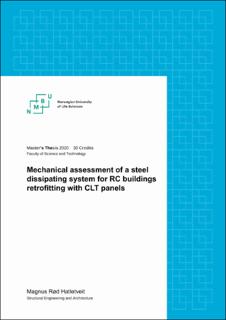| dc.contributor.advisor | Tomasi, Roberto | |
| dc.contributor.advisor | Boggian, Francesco | |
| dc.contributor.author | Hatletveit, Magnus Rød | |
| dc.date.accessioned | 2021-01-19T22:33:19Z | |
| dc.date.available | 2021-01-19T22:33:19Z | |
| dc.date.issued | 2020 | |
| dc.identifier.uri | https://hdl.handle.net/11250/2723785 | |
| dc.description.abstract | Lack of seismic capacity is a common problem for older low-rise, reinforced concrete frame structures. To tackle this problem, a new friction energy dissipating system meant for retrofitting, is proposed. The system consists of externally mounted CLT-elements connected with steel profiles to the beams of reinforced concrete (RC) buildings. Each of the steel profiles consists of two separate plates, linked through a friction connection consisting of preloaded bolts sliding in elongated holes.
As the project is in its early stages, the author has been tasked with determining the capacity of three proposed profile designs, as well as creating improved profile designs. To do this, a combination of hand calculations and FEM modeling in Ansys® Academic Research Workbench, Release 19.2 has been performed.
To determine the slip force of the friction connection, a separate simulation was devised to test the equations derived for the hand calculations. From this test, the results showed strong correlation with the equation derived from the hand calculations, and suggested two effective friction surfaces per preloaded bolt for the single lap jointed friction connection.
For the profile simulations, the supports were modeled as two elements consisting of the steel plate and a combined element, consisting of the CLT/concrete and the connectors. The external profile loading was derived from an approach based on the moment distribution of the CLT element resulting from the applied seismic shear forces.
In total, six different profiles were examined in this thesis. The base profile applied a simple design, where the plate connected to the front of the CLT-element and bent around the element towards the RC-beam. From the modeling, it was determined that all these designs with front mounted CLT-steel connections would induce large eccentricities, resulting in unfavorable moment stresses acting in the plates and connections.
For the rear mounted CLT-steel connection profile designs, it was observed that these eccentric moments were greatly reduced. As a result, a new profile design, attempting to reduce the system eccentricity was tested. With exception of the friction connection, this new design greatly improved the profile stresses. In addition, a new proposal for the concrete connection was designed for the profile, increasing the center distances and diameter of the concrete anchors. This resulted in greatly improved concrete capacity.
The rear mounted design required a new mounting procedure, as the original approach intended to mount the profiles before installing the CLT-elements. As a result, a new simplified mounting procedure, as well as a new profile adjustment concept was proposed for the rear mounted CLT-steel profile.
For the friction connections, large stress concentrations were observed around the preloaded bolts for all the profiles. It was determined that an elastic-plastic analysis would be required for these connections, as EN 1993-1-8:2005 utilized a plastic capacity calculation for bolt connections.
Lastly, the characteristic slip load of the friction dissipating system was compared to an estimated optimal slip load for a representable structure. The results indicated that the system as calculated, would be capable of providing optimal slip load for lower seismic regions, but would likely need an increased slip capacity for higher seismic regions. | en_US |
| dc.description.abstract | Manglende seismisk kapasitet er et vanlig problem for eldre blokker med rammekonstruksjoner av betong. I denne oppgaven, analyseres en ny type friksjonsdemper. Systemet består av utvendig monterte krysslaminerte elementer, festet til det eksisterende bygget med stålprofiler. Hver av disse profilene består av to separate stålplater, forbundet med forspente skruer, utformet for å skli i avlange under seismiske hendelser.
Ettersom prosjektet er i oppstartsfasen, har forfatteren fått i oppgave å estimere kapasiteten til tre forhåndsbestemte profil design. Basert på disse resultatene, skal forfatteren foreslå nye profil design. For å gjennomføre disse oppgavene, har forfatteren benyttet en kombinasjon av hånd beregninger og FEM analyser ved hjelp av Ansys® Academic Research Workbench, Release 19.2.
For å bestemme nødvendig forspenning av skruene i friksonsforbindelsen til de forskjellige profilene, ble det utviklet en separat FEM-modell. Fra disse simuleringene ble det funnet en sterk korrelasjon mellom nødvendig forspenning utledet for håndberegningen og simuleringene. I tillegg, indikerte simuleringene to effektive friksjons flater for den enkelt skjøtede forbindelsen.
For modelleringen av de forskjellige profilene, ble opplagerforbindelsene modellert som to elementer, bestående av profilens stålplate og ett kombinert element bestående av CLT/betong elementene og de tilhørende forbinderne. De eksterne kreftene som virket på de forskjellige opplagerne til profilene, ble estimert fra moment fordelingen som resulterte fra CLT-elementene påvirket av seismiske skjærkrefter.
Totalt, ble seks forskjellige profiler testet i denne oppgaven. De originale profilene, hadde et design hvor stål platen var festet på forsiden av CLT-elementene, og deretter ble bøyd mot betong bjelken. Fra simuleringen av disse profilene, ble det observer store spenninger i platene og forbindelsene, som resulterte fra de horisontale eksentrisitetene mellom betong og CLT opplagerne. | en_US |
| dc.language.iso | eng | en_US |
| dc.publisher | Norwegian University of Life Sciences, Ås | en_US |
| dc.rights | Attribution-NonCommercial-NoDerivatives 4.0 Internasjonal | * |
| dc.rights.uri | http://creativecommons.org/licenses/by-nc-nd/4.0/deed.no | * |
| dc.subject | Damper | en_US |
| dc.subject | Seismic | en_US |
| dc.subject | CLT | en_US |
| dc.subject | Friction | en_US |
| dc.title | Mechanical assessment of a steel dissipating system for RC buildings retrofitting with CLT panels | en_US |
| dc.type | Master thesis | en_US |
| dc.description.version | submittedVersion | en_US |
| dc.subject.nsi | VDP::Teknologi: 500::Bygningsfag: 530::Konstruksjonsteknologi: 533 | en_US |
| dc.source.pagenumber | 96. | en_US |
| dc.description.localcode | M-BA | en_US |

